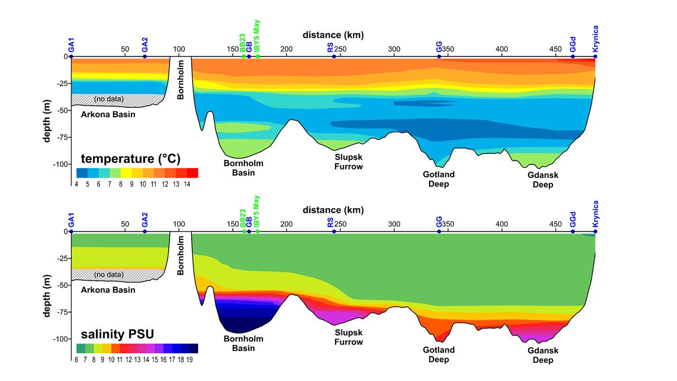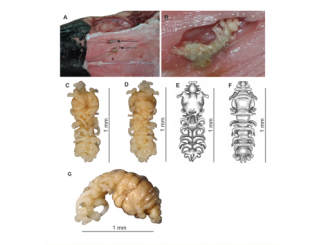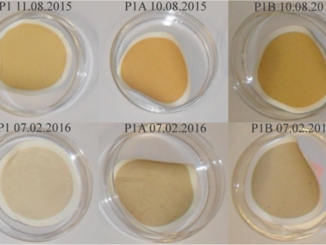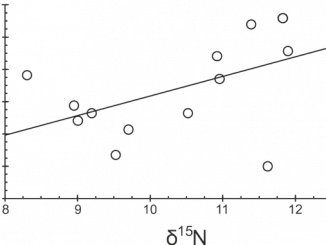
Paper category: Original research paper
Corresponding author: Małgorzata Dembek (mdembek@mir.gdynia.pl)
DOI: 10.2478/ohs-2019-0030
Received: 15/02/2019
Accepted: 23/04/2019
Full text: here
Citation (APA style): Dembek, M., Bielecka, L., Margoński, P., et al. (2019). Changes in the composition and abundance of ichthyoplankton along environmental gradients of the southern Baltic Sea. Oceanological and Hydrobiological Studies, 48(4), pp. 328-336. Retrieved 10 Dec. 2019, from doi:10.2478/ohs-2019-0030
Abstract
The research focuses mainly on the ichthyoplankton of the Baltic deeps – the inflow route from the North Sea. The ichthyoplankton was represented by eggs and larvae of nine fish species: sprat, cod, herring, European flounder, fourbeard rockling, longspined bullhead, straightnose pipefish, sand goby and great sandeel. The species composition of ichthyoplankton varied depending on the location of a given site – the number of taxa ranged from one to five. The Slupsk Furrow was the most diversified area in terms of the number of taxa, while the highest abundance of ichthyoplankton occurred in the Bornholm Basin. The sprat clearly dominated and inhabited all the surveyed depths. Of the remaining species, only cod eggs as well as eggs and larvae of the fourbeard rockling significantly contributed to this formation. They occurred within their main spawning grounds (Bornholm Deep in the near-bottom layers) and secondary spawning grounds (Slupsk Furrow and Gdansk Deep) where salinity and oxygenation of water favored their development. Biometric research has shown that the diameter of eggs was within the size range typical of the Baltic Sea.
References
Arndt, E.A. (1989). Ecological, physiological and historical aspects of brackish water fauna distribution. Reproduction, genetics and distribution of marine organisms. Olsen & Olsen, Fredensborg 327–338.
Bagge, O. & Thurow, F. (1994). The Baltic cod stock: fluctuations and possible causes. In ICES Marine Science Symposia 198: 254–268.
Bailey, K.M. & Houde, E.D. (1989). Predation on eggs and larvae of marine fishes and the recruitment problem. In Advances in Marine Biology 25: 1–83. Academic Press.
Baumann, H., Hinrichsen, H.H., Möllmann, C., Köster, F.W., Malzahn, A.M. et al. (2006). Recruitment variability in Baltic Sea sprat (Sprattus sprattus) is tightly coupled to temperature and transport patterns affecting the larval and early juvenile stages. Canadian Journal of Fisheries and Aquatic Sciences 63(10): 2191–2201. DOI:10.1139/f06-112.
Botros, A.G. (1962). Die Fruchtbarkeit des Dorsches (Gadus morhua L.) in der westlichen Ostsee und den westnorwegischen Gewässern. Kieler Meeresforschungen 18: 67–80.
Horbowa, K. & Fey, D. (2013). Atlas wczesnych stadiów rozwojowych ryb. 34 gatunki ryb Południowego Bałtyku i jego zalewów. Gdynia: Morski Instytut Rybacki, 152 pp.
Hinrichsen, H.H., Böttcher, U., Köster, F.W., Lehmann, A. & John, M.S. (2003). Modelling the influences of atmospheric forcing conditions on Baltic cod early life stages: distribution and drift. Journal of Sea Research 49(3): 187–201. DOI: 10.1016/S1385-1101(03)00006-6.
Karaseva, E.M., Zezera, A.S. & Ivanovich, V.M. (2012). Changes in the species composition and ichthyoplankton abundance along transects in the Baltic Sea. Oceanology 52(4): 478–487. DOI: 10.1134/S0001437012040030.
Kornilovs, G., Sidrevics, L. & Dippner, J. W. (2001). Fish and zooplankton interaction in the Central Baltic Sea. ICES Journal of marine science 58(3): 579–588. DOI: 10.1006/jmsc.2001.1062.
Kraus, G. & Köster, F.W. (2004). Estimating Baltic sprat population sizes from egg production. Fisheries Research 69(3): 313–329. DOI: 10.1016/j.fishres.2004.06.005.
Köster, F.W., Möllmann, C., Neuenfeldt, S., Vinther, M., St John, M.A. et al. (2003). Fish stock development in the central Baltic Sea (1974–1999) in relation to variability in the environment. In ICES Marine Science Symposia 219: 294–306.
Kullenberg, G. & Jacobsen, T.S. (1981). The Baltic Sea: an outline of its physical oceanography. Great Britain: Marine pollution bulletin 12(6): 183–186. DOI: 10.1016/0025-326X(81)90168-5.
Matthäus, W. & Ulrich Lass, H. (1995). The recent salt inflow into the Baltic Sea. Journal of Physical Oceanography 25(2): 280–286. DOI: 10.1175/1520-0485(1995)0252.0.CO;2}.
Mohrholz, V., Naumann, M., Nausch, G., Krüger, S. & Gräwe, U. (2015). Fresh oxygen for the Baltic Sea – An exceptional saline inflow after a decade of stagnation. Journal of Marine Systems 148: 152–166. DOI: 10.1016/j.jmarsys.2015.03.005.
Munk P. & Nielsen J.G. (2005). Eggs and Larvae of North Sea Fishes. Biofolia, Denmark, 533 pp.
Neumann, V., Schaber, M., Eero, M., Böttcher, U. & Köster, F.W. (2016). Quantifying predation on Baltic cod early life stages. Canadian Journal of Fisheries and Aquatic Sciences 74(6): 833–842. DOI: 10.1139/cjfas-2016-0215.
Nissling, A., Müller, A. & Hinrichsen, H.H. (2003). Specific gravity and vertical distribution of sprat eggs in the Baltic Sea. Journal of Fish Biology 63(2): 280–299. DOI: 10.1046/j.1095-8649.2003.00139.x.
Ojaveer, E. & Kalejs, M. (2005). The impact of climate change on the adaptation of marine fish in the Baltic Sea. ICES Journal of Marine Science. 62(7): 1492–1500. DOI: 10.1016/j.icesjms.2005.08.002.
Russell F.S. (1976). The Eggs and Planktonic Stages of British Marine Fishes. London: Academic Press, 524 pp.
Schopka S.A. (1971). Vergleichende Untersuchungen zur Fortpflanzungsrate bei Herings- und Kabeljaupopulationen (Clupea harengus L. and Gadus morhua L.) Trans. Ser. Fish. Res. Board Can. 22(1): 3–79.
Skóra, K.E. (2001). The broad-nosed pipefish. Polish Red Data Book of Animals. Vertebrates. Warszawa: PWRiL, 316–318.
Snoeijs-Leijonmalm, P. & Andrén, E. (2017). Why is the Baltic Sea so special to live in? Biological Oceanography of the Baltic Sea 23–84. DOI: 10.1007/978-94-007-0668-2_2.
Sparholt, H. (1994). Fish species interactions in the Baltic Sea. Dana 10: 131–162.
Sparholt, H. (1996). Causal correlation between recruitment and spawning stock size of central Baltic cod? ICES Journal of Marine Science 53(5): 771–779. DOI: 10.1006/jmsc.1996.0098.
Svedäng, H. & Bardon, G. (2003). Spatial and temporal aspects of the decline in cod (Gadus morhua L.) abundance in the Kattegat and eastern Skagerrak. ICES Journal of Marine Science. 60(1): 32–37. DOI: 10.1006/jmsc.2002.1330.
Voss, R., Clemmesen, C., Baumann, H. & Hinrichsen, H.H. (2006). Baltic sprat larvae: coupling food availability, larval condition and survival. Marine Ecology Progress Series 308: 243–254. DOI: 10.3354/meps308243.
Voss, R., Hinrichsen, H.H., Quaas, M.F., Schmidt, J.O., & Tahvonen, O. (2011a). Temperature change and Baltic sprat: from observations to ecological–economic modelling. ICES Journal of Marine Science 68(6): 1244–1256. DOI: 10.1093/icesjms/fsr063.
Voss, R., Hinrichsen, H.H., Stepputtis, D., Bernreuther, M., Huwer, B. et al. (2011b). Egg mortality: predation and hydrography in the central Baltic. ICES Journal of Marine Science 68(7): 1379–1390. DOI: 10.1093/icesjms/fsr061.




Be the first to comment